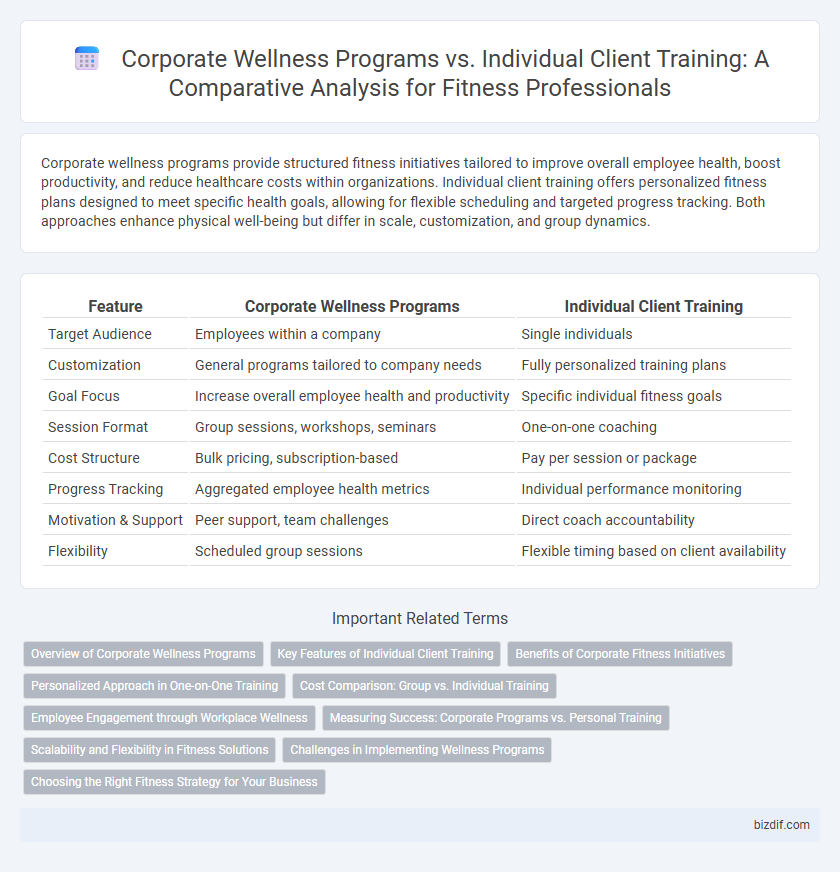Corporate wellness programs provide structured fitness initiatives tailored to improve overall employee health, boost productivity, and reduce healthcare costs within organizations. Individual client training offers personalized fitness plans designed to meet specific health goals, allowing for flexible scheduling and targeted progress tracking. Both approaches enhance physical well-being but differ in scale, customization, and group dynamics.
Table of Comparison
| Feature | Corporate Wellness Programs | Individual Client Training |
|---|---|---|
| Target Audience | Employees within a company | Single individuals |
| Customization | General programs tailored to company needs | Fully personalized training plans |
| Goal Focus | Increase overall employee health and productivity | Specific individual fitness goals |
| Session Format | Group sessions, workshops, seminars | One-on-one coaching |
| Cost Structure | Bulk pricing, subscription-based | Pay per session or package |
| Progress Tracking | Aggregated employee health metrics | Individual performance monitoring |
| Motivation & Support | Peer support, team challenges | Direct coach accountability |
| Flexibility | Scheduled group sessions | Flexible timing based on client availability |
Overview of Corporate Wellness Programs
Corporate wellness programs are structured initiatives implemented by organizations to improve employees' health, increase productivity, and reduce healthcare costs through group fitness sessions, health screenings, and educational workshops. These programs emphasize preventive care and create a culture of wellness by offering accessible fitness resources and incentives that encourage consistent physical activity among employees. Companies investing in comprehensive wellness strategies often see measurable improvements in employee morale, reduced absenteeism, and enhanced overall workplace performance.
Key Features of Individual Client Training
Individual client training offers personalized workout plans tailored to specific fitness goals, ensuring maximum efficiency and measurable progress. Sessions provide one-on-one attention from certified trainers who adjust techniques and intensity based on real-time feedback. This approach fosters accountability, motivation, and customized nutrition guidance, enhancing overall health outcomes and injury prevention.
Benefits of Corporate Fitness Initiatives
Corporate fitness initiatives enhance employee productivity by reducing stress and improving overall health, which leads to decreased absenteeism and lower healthcare costs. These programs foster team building and boost morale through group activities that create a supportive work environment. Compared to individual client training, corporate wellness programs offer scalable solutions that deliver measurable improvements in workforce well-being and organizational performance.
Personalized Approach in One-on-One Training
One-on-one training offers a highly personalized approach tailored to individual fitness levels, goals, and health conditions, enhancing motivation and accountability. Corporate wellness programs typically address a broader audience with standardized routines, often limiting customization but promoting teamwork and overall employee well-being. Personalized training maximizes results through expert guidance, specific exercise programming, and real-time feedback, fostering rapid progress and injury prevention.
Cost Comparison: Group vs. Individual Training
Corporate wellness programs typically offer cost-effective group training sessions that reduce per-person expenses by sharing instructor fees and facility costs across multiple employees. Individual client training commands higher rates due to personalized attention, customized workout plans, and one-on-one coaching, which elevate the overall investment per participant. Businesses aiming to maximize ROI on employee health often choose group training formats, while clients seeking tailored fitness solutions may prioritize individual sessions despite the increased cost.
Employee Engagement through Workplace Wellness
Corporate wellness programs significantly enhance employee engagement by fostering a culture of health within the workplace, leading to reduced absenteeism and increased productivity. In contrast, individual client training offers personalized fitness solutions but may lack the collective motivation and accountability found in group settings. Workplace wellness initiatives boost team morale and create supportive environments, enhancing overall employee well-being more effectively than solitary training regimens.
Measuring Success: Corporate Programs vs. Personal Training
Corporate wellness programs often utilize aggregated health metrics such as employee participation rates, biometric screenings, and productivity improvements to measure overall program success. In contrast, personal training relies on individualized progress tracking through specific fitness assessments, goal attainment, and client feedback. Both approaches use data-driven insights, but corporate programs emphasize broad health trends, whereas personal training focuses on tailored performance outcomes.
Scalability and Flexibility in Fitness Solutions
Corporate wellness programs offer scalable fitness solutions designed to engage large employee groups through standardized workout plans and group activities, optimizing resource allocation and consistency across the organization. Individual client training provides flexible, personalized fitness regimens tailored to specific goals, allowing adjustments based on real-time progress and unique health needs. Scalability favors corporate programs with their capacity for mass participation, while flexibility is maximized in one-on-one training environments that accommodate individual preferences and schedules.
Challenges in Implementing Wellness Programs
Implementing corporate wellness programs faces challenges such as diverse employee needs, limited participation, and varying commitment levels across departments. Ensuring program scalability and maintaining sustained engagement require tailored strategies to address organizational culture and resource constraints. Balancing personalized fitness goals with standardized wellness initiatives often results in reduced effectiveness compared to individualized client training.
Choosing the Right Fitness Strategy for Your Business
Corporate wellness programs enhance employee health and productivity by providing structured fitness initiatives tailored to group dynamics, reducing absenteeism and healthcare costs. Individual client training offers personalized workout plans targeting specific goals, maximizing motivation and results through one-on-one coaching. Selecting the right fitness strategy depends on business size, employee needs, and budget, ensuring alignment with organizational objectives and workforce engagement.
Corporate Wellness Programs vs Individual Client Training Infographic

 bizdif.com
bizdif.com